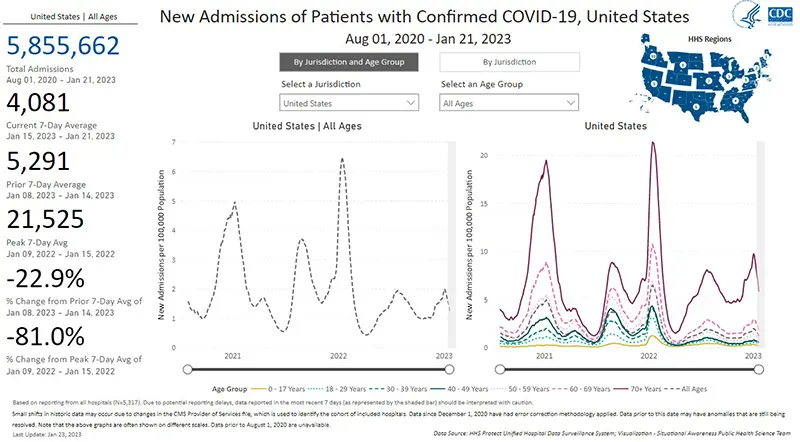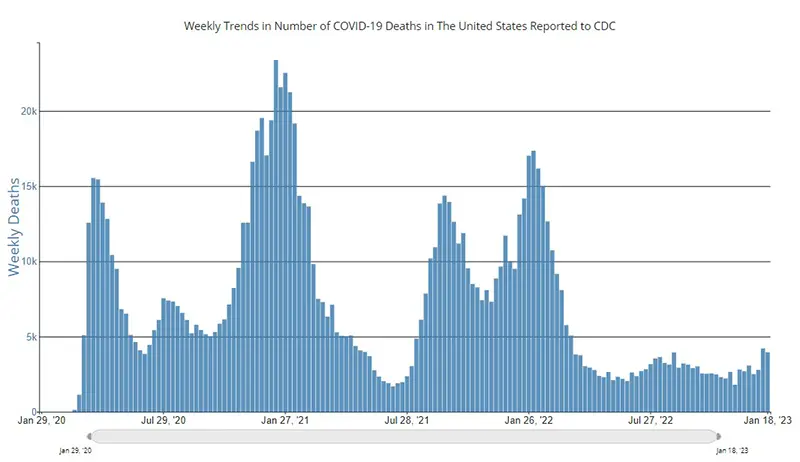Weekly COVID-19 Statistics
Here is this week’s CDC’s map of community level of spread (this particular link is weighted based on hospitalizations and not the actual level of spread). And here is the link to the New York Times actual cases per capita map as pictured below. The New York Times data was last updated January 23rd.

Here is the summary graphic from the New York Times as of January 23rd. It is highly encouraging to finally see all metrics reflecting a negative downturn in the 14-day change column after so many weeks of repetitive increases!

Here is a graphic from the Wastewater Monitoring Project last updated January 23rd. This graphic indicates the downward trend in case numbers as reflected above by showing there has been lower amount of SARS-CoV-2 virus detected in wastewater. The top dark blue line (which reflects the amount of coronavirus measured in wastewater) continues to show a stark contrast to the lower light blue line (which reflects the actual reported case numbers from health departments). This means that although a lower number of case numbers are being reported, there is still a large gap in the reported numbers and actual cases.

The additional graphic below from the Wastewater Project shows SARS-CoV-2 viral concentrations by region. All regions appear to be having a downward trend, with numbers still remaining the highest in the Northeast where the variant XBB.1.5 has taken hold over the past several weeks

The rate of hospitalizations, last updated January 21st, thankfully indicate a sharp decrease as well (gray dotted line graphic on the left). While there continues to be a contrast in the number of hospitalizations for those over the age of 70 (purple solid line on the right), that age group has experienced a large decrease in hospitalizations from the week prior.

The weekly average number of COVID-19 deaths according to the CDC in the US ending the week of January 18th were 3,907. This is a decrease of 302 deaths on average from the week prior.

Current & Emerging Variants of Concern (VOC)
XBB.1.5 (some may have heard this variant recently referred to as the Kraken variant) continues to outcompete all others in the US. Here is the overall breakdown of variants in the US according to the CDC’s Variant Tracker as of January 21st.
And here is the BA.5 breakdown by region within the United States. We are continuing to show the proportion of BA.5 that remains by region, as it is one of the few remaining variants with the highest proportion (although not that much) that is still neutralized by Evusheld. You will notice that BA.5 now only makes up 0.3% of cases in the New York State region but is still holding at 9.4% of cases in the Midwest.

As a summary, data indicate Evusheld will still provide protection against the following variants (remember percentages are national averages and vary by region). Note that these overall percentages of variants that continue to have neutralizing capacity against the virus are at all-time combined lows and continue trending downward each week.
- BA.5 (2.0%)
- BN.1 (1.8%)
- BA.2.75 (1.6%)
- BA.2 (0.2%)
These four variants that are neutralized by Evusheld together make up only ~5.6% of cases on average nationwide as of January 21st!
Please discuss any questions you might have surrounding Evusheld with your healthcare provider.
Data indicate that Evusheld will NOT be effective against the remainder of variants in the US that are not mentioned specifically as the above four variants. (We are no longer going to list each of the variants that are not neutralized by Evusheld, as they are too numerous).
In Summary
If you missed the article that discusses the FDA’s most recent guidance on COVID-19 testing recommendations, you can read more here. Please remember, if you have known exposure to COVID-19 or are experiencing any symptoms at all, please get tested early, preferably with a PCR test, and call your healthcare provider. Paxlovid must be started orally within five days of symptom onset and Remdesivir must be started intravenously within seven days of symptom onset.
Please wear a well-fitted N95 mask (or KN95) while around others who live outside of your household. You can obtain quality N95 masks free of charge from many local pharmacies across the country.
If you missed CLL Society’s COVID-19 webinar last week, you can watch it on demand here.
Keep learning, and please stay well.
Robyn Brumble, MSN, RN
Director of Scientific Affairs & Research
CLL Society

















